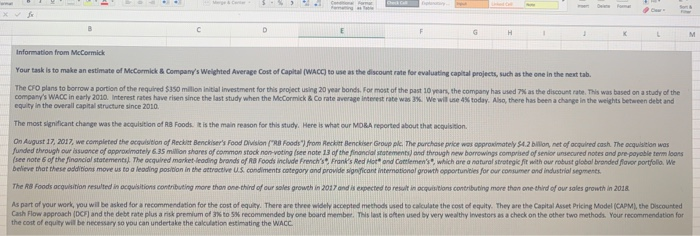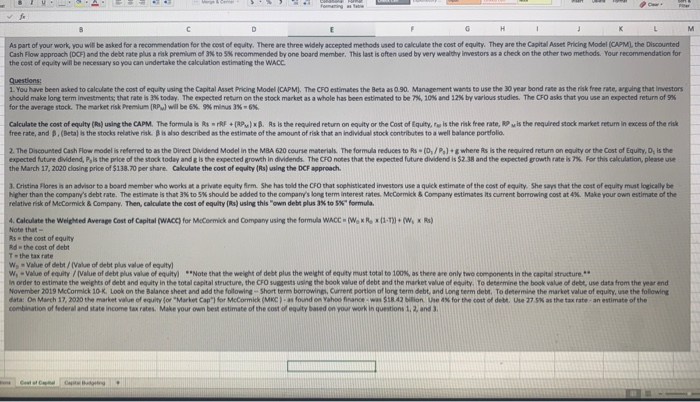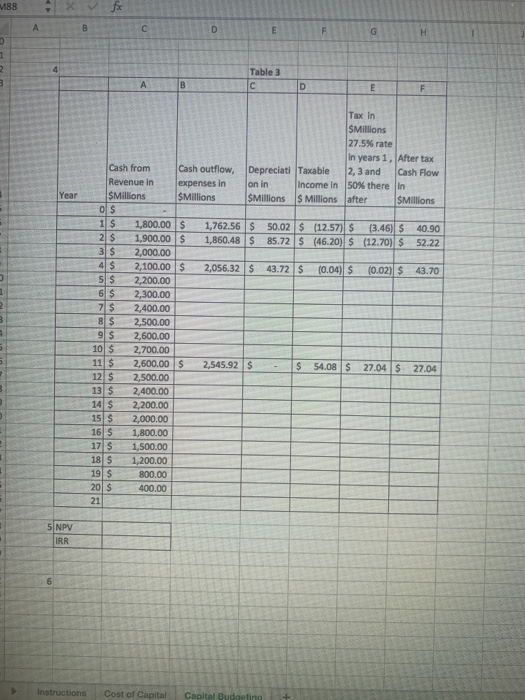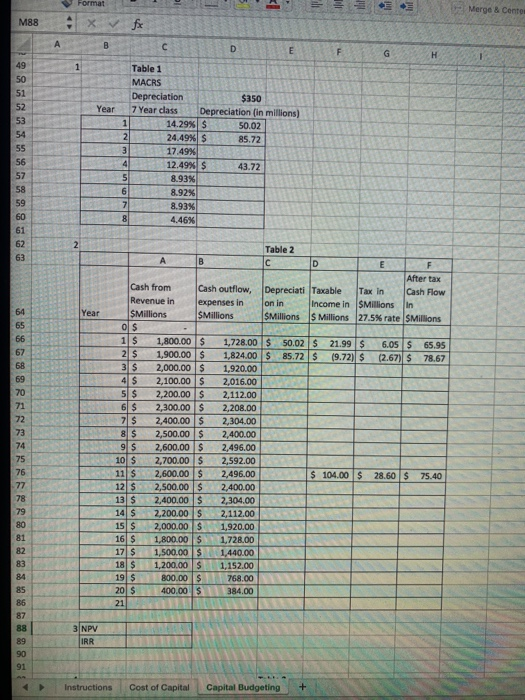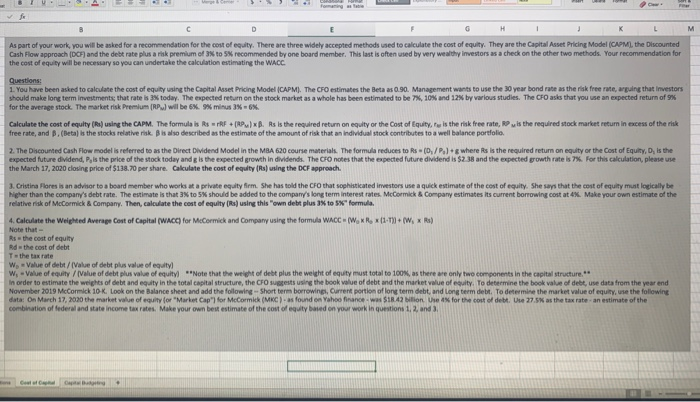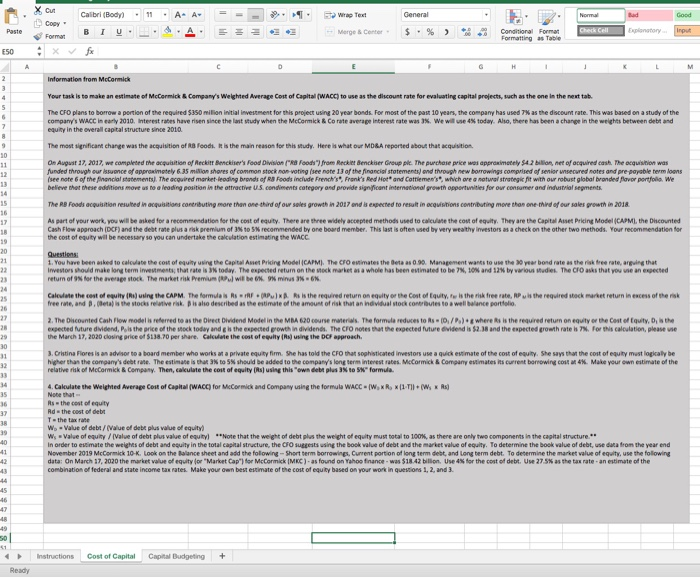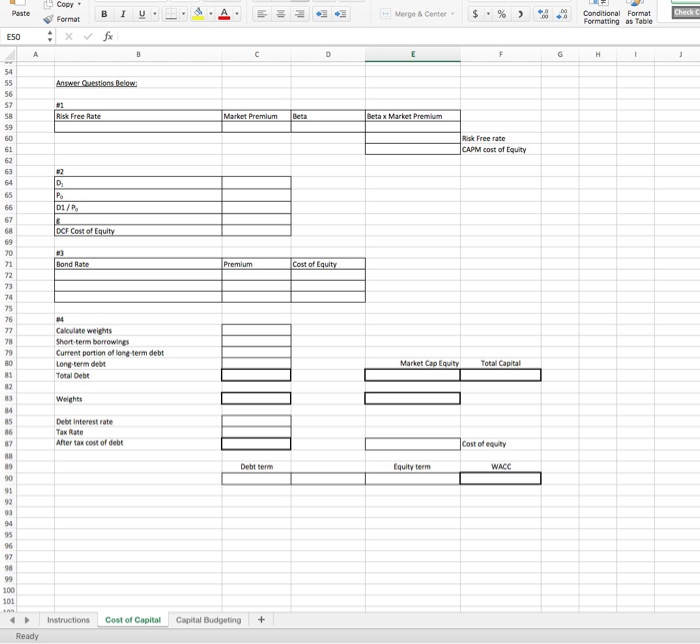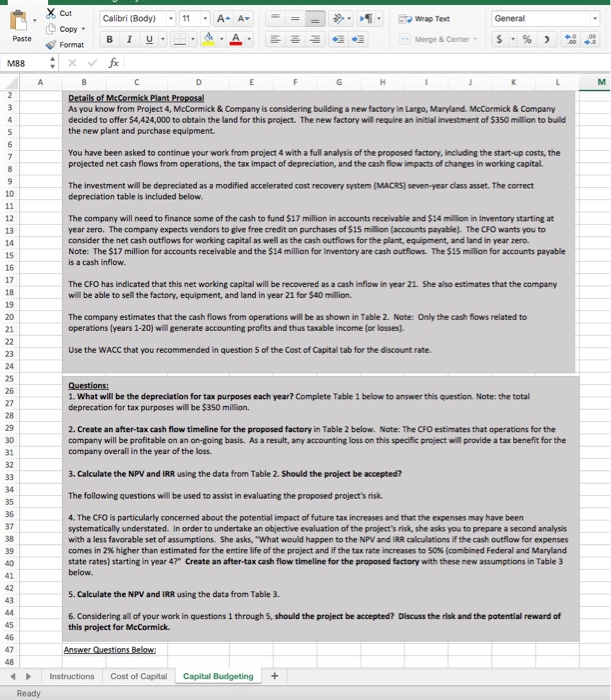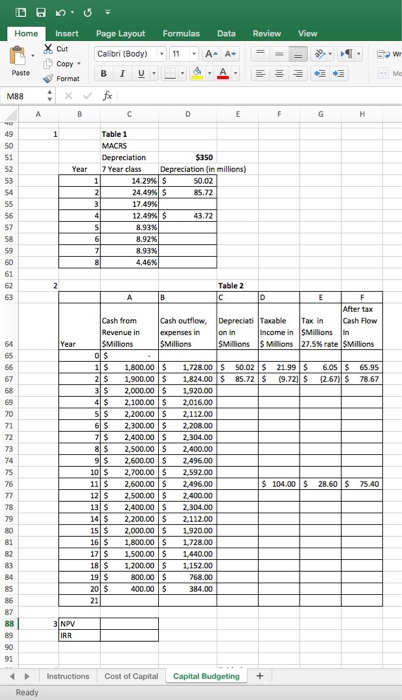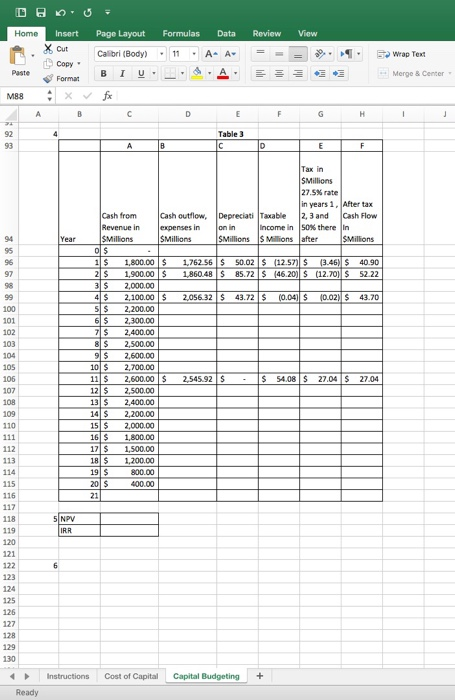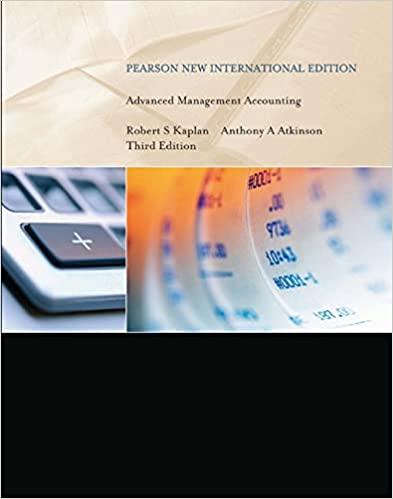please calculate and answer the questions below. Formulas for Excell needed as well.
D G H K M Information from McCormick Your task is to make an estimate of McCormick & Company's Weighted Average Cost of Capital (WACC) to use as the discount rate for evaluating capital projects, such as the one in the next tab. The CFO plans to borrow a portion of the required $350 milion initial investment for this project using 20 year bondi. For most of the past 10 years, the company has used as the discount rate. This was based on a study of the company's WACC in early 2010. Interest rates have risen since the last study when the McCormick & Co rate average interest rate was. We will see today. Also, there has been a change in the weights between debt and equity in the overall capital structure since 2010 The most significant change was the acquisition of RB Foods. It is the main reason for this study. Here is what our MOBA reported about that acquisition On August 17, 2017, we completed the acquisition of Reckitt Benckiser's Food Division/" Foods") from Recht Benckiser Group ple. The purchase price was approximately 51.2 billion, net of acquired cash. The acquisition was funded through our sence of approximately 6.35 milion shares of common stock non voting fee note 13 of the financial statements and through new borrowings comprised of senior unsecured notes and prepoyable termoor see note of the financial statements. The acquired market leading brands of Foods include French's Frank's Red Hot and Cattlemen's", which are a natural strategies fit with our robust global branded favor portfolio We believe that these additions move us to a leading position in the attractive U.S. condiments category and provide significant international growth opportunities for our consumer and industrial segments. The R8 Foods couisition resulted in acquisitions contributing more than one-third of our sales growth in 2017 and is expected to result in acquisitions contributing more than one-third of our sales growth in 2018 As part of your work, you wil be asked for a recommendation for the cost of equity. There are three widely accepted methods used to calculate the cost of equity. They are the Capital Asset Pricing Model (CAPM), the Discounted Cash Flow approach (DCF) and the debt rate plus a risk premium of 3 to recommended by one board member. This last is often used by very wealthy Investors as a check on the other two methods. Your recommendation for the cost of equity will be necessary so you can undertake the calculation estimating the WACC forg D H K M As part of your work, you will be asked for a recommendation for the cost of equity. There are three widely accepted methods used to calculate the cost of equity. They are the Capital Asset Pricing Model (APM), the Discounted Cash Flow approach (DCF) and the debt rate plus a risk premium of 3% to 5% recommended by one board member. This last is often used by very wealthy investors as a check on the other two methods. Your recommendation for the cost of equity will be necessary so you can undertake the calculation estimating the WACC Questions: 1. You have been asked to calculate the cost of equity using the Capital Asset Pricing Model (CAPM). The CFO estimates the Beta as 0.90. Management wants to use the 30 year bond rate as the risk free rate, arguing that investors should make long term investments that rate is 3x today. The expected return on the stock market as a whole has been estimated to be 7%, 10% and 12% by various studies. The CFO asks that you use an expected return of 9% for the average stock. The market risk Premium (RP) wil be 6.9% minus 3% -6%. Calculate the cost of equity (Re) using the CAPM. The formula is Rs =rRF + RPM)x. Rs is the required return on equity or the cost of Equity, tu is the risk free rate, is the required stock market retum in excess of the risk free rate, and .(Betais the stocks relative risk B is also described as the estimate of the amount of risk that an individual stock contributes to a well balance portfolio 2. The Discounted Cash Flow model is referred to as the Direct Dividend Model in the MBA 620 course materials. The formula reduces to Rs-(0/P.I+g where Rs is the required return on equity or the cost of Equity, D, is the expected future dividend, P, is the price of the stock today and is the expected growth in dividends. The CFO notes that the expected future dividend is $2.38 and the expected growth rate is 7%. For this calculation, please use the March 17, 2020 closing price of $138.70 per share. Calculate the cost of equity (Rs) using the DCF approach. 3. Cristina Flores is an advisor to a board member who works at a private equity firm. She has told the CFO that sophisticated investors use a quick estimate of the cost of equity. She says that the cost of equity must logically be higher than the company's debt rate. The estimate is that 3% to 5% should be added to the company's long term interest rates. McCormick & Company estimates its current borrowing cost at 4%. Make your own estimate of the relative risk of McCormick & Company. Then, calculate the cost of equity (Rs) using this own debt plus 3% to 5x" formula 4. Calculate the weighted Average Cost of Capital (WACC) for McCormick and Company using the formula WACC (W XR, * (1-1+ (W x Rs) Rs the cost of equity Rd the cost of debt To the tax rate WValue of debt / (Value of debt plus value of equity) W-Value of equity / Value of debt plus value of equity **Note that the weight of debt plus the weight of equity must total to 100%, as there are only two components in the capital structure." In order to estimate the weights of debt and equity in the total capital structure, the CFO suggests using the book value of debt and the market value of equity. To determine the book value of debt, use data from the year end November 2019 McCormick 10K. Look on the Balance sheet and add the following-Short term borrowings, Current portion of long term debt, and long term debt. To determine the market value of equity, use the following data: on March 17, 2020 the market value of equity for Market Cap" for McCormick (MUC) - as found on Yahoo finance was $18.42 bilion. Used for the cost of debt. Use 27.5% as the tax rate an estimate of the combination of federal and state income tax rates. Make your own best estimate of the cost of equity based on your work in questions 1, 2 and 3 Note that MB8 . fa B c D E F G H 1 2 3 Table 3 IC A B D E F Year Tax In SMillions 27.5% rate in years 1, After tax Cash from Cash outflow, Depreciati Taxable 2,3 and Cash Flow Revenue in expenses in on in Income in 50% there in SMillions SMillions $Millions $ Millions after SMillions 0 $ 1 $ 1,800.00 $ 1,762.56 $ 50.02 $ (12.57) $ (3.46) $ 40.90 2 $ 1,900.00 $ 1,860.48 $ 85.72 $ (46.20) $ (12.70) $ 52.22 3 $ 2,000.00 4 $ 2,100.00 S 2,056.32 $ 43.72 $ (0.04) $ (0.02) $ 43.70 S $ 2,200.00 6 $ 2,300.00 7 $ 2,400.00 8 $ 2,500.00 9 $ 2,600.00 10 S 2,700.00 11 $ 2,600.00 $ 2,545.92 $ $ 54.08 $ 27.04 $ 27.04 12 $ 2,500.00 13 $ 2,400.00 14 $ 2,200.00 15 $ 2,000.00 16 $ 1,800.00 17 $ 1,500.00 18$ 1,200.00 19 $ 800.00 20 $ 400.00 21 5 NPV IRR 6 Instructions Cost of Capital Capital Budgeting Format - TE JE lit M 3 i Merge & Center M88 x x B D E F G H 1 Year 49 50 51 52 53 54 55 56 57 58 59 60 61 62 63 1 2 3 4 5 6 7 8 Table 1 MACRS Depreciation $350 7 Year class Depreciation (in millions) 14.29% 50.02 24.49% $ 85.72 17.49% 12.49% S 43.72 8.93% 8.92% 8.93% 4.46% 2 Year 64 65 66 67 68 69 70 71 72 73 74 75 76 77 78 79 80 81 82 83 84 85 86 87 88 89 90 91 Table 2 A B C D E F After tax Cash from Cash outflow, Depreciati Taxable Tax in Cash Flow Revenue in expenses in on in Income in Millions in $Millions $Millions SMillions $ Millions 27.5% rate SMillions os 1 $ 1,800.00 $ 1,728.00 $ 50.02 $21.99 $ 6.05$ 65.95 2 $ 1,900.00 $ 1,824.00 $ 85.72 $ (9.72) $ (2.67) $ 78.67 3 $ 2,000.00 $ 1,920.00 4 $ 2,100.00 $ 2,016.00 5 $ 2,200.00 S 2,112.00 6 $ 2,300.00 $ 2,208.00 7 $ 2,400.00 $ 2,304.00 8 $ 2,500.00 $ 2,400.00 9 $ 2,600.00 2,496.00 10 $ 2,700.00 $ 2,592.00 11 s 2,600.00 $ 2,496.00 $ 104.00 $ 28.60 $ 75.40 12 s 2,500.00 $ 2,400.00 13 S 2,400.00 $ 2,304.00 14 $ 2,200.00 $ 2,112.00 15$ 2,000.00 1,920.00 16 $ 1,800.00 $ 1,728.00 17 $ 1,500.00 $ 1,440.00 18$ 1,200.00 $ 1,152.00 19 $ 800.00 $ 768.00 20$ 400.00 $ 384.00 21 3 NPV IRR Instructions Cost of Capital Capital Budgeting + Information from McCormick Your task is to make an estimate of McCormick & Company's Weighted Average Cost of Capital (WACC) to use as the discount rate for evaluating capital projects, such as the one in the next tab. The CFO plans to borrow a portion of the required 5350 milion initial investment for this project using 20 year bonds. For most of the past 10 years, the company has used as the discount rate. This was based on a study of the company's WACC in early 2010. Interest rates have risen since the last study when the McCormick & Co rate average interest rate was. We will use 4% today. Also, there has been a change in the weights between debt and equity in the overall capital structure since 2010 The most significant change was the acquisition of Ra Foods. It is the main reason for this study. Here is what our MOBA reported about that acquisition On August 17, 2017, we completed the acquisition of Reckitt Benckiser's Food Division ( foods from Recht Benckiser Group ple. The purchase price was approximately 1.2 billion, net of acquired cash. The acquisition was funded through our sence of approximately 6.35 milion shares of common stock non voting free note 13 of the financial statements and through new borrowings comprised of senior unsecured notes and prepayable term loons see note of the financial statements. The acquired market leading brands of Foods include French's Frank's Red Hot and Cattlemen's", which are a natural strategie it with our robust global branded favor portfolio We believe that these additions move us to a leading position in the attractive U.S. condiments cotegory and provide significant international growth opportunities for our consumer and industrial segments The R8 Foods acquisition resulted in acquisitions contributing more than one-third of our sales growth in 2017 and is expected to result in acquisitions contributing more than one-third of our sales growth in 2018 As part of your work, you will be asked for a recommendation for the cost of equity. There are three widely accepted methods used to calculate the cost of equity. They are the Capital Asset Pricing Model (CAPM), the Discounted Cash Flow approach (DCF) and the debt rate plus a risk premium of 3 to recommended by one board member. This last is often used by very wealthy investors as a check on the other two methods. Your recommendation for the cost of equity will be necessary so you can undertake the calculation estimating the WACC Information from McCormick Your task is to make an estimate of McCormick & Company's Weighted Average Cost of Capital (WACC) to use as the discount rate for evaluating capital projects, such as the one in the next tab. The CFO plans to borrow a portion of the required 5350 milion initial investment for this project using 20 year bondi. For most of the past 10 years, the company has used as the discount rate. This was based on a study of the company's WACC in early 2010. Interest rates have risen since the last study when the McCormick & Co rate average interest rate was. We will use 4% today. Also, there has been a change in the weights between debt and equity in the overall capital structure since 2010. The most significant change was the acquisition of Ra Foods. It is the main reason for this study. Here is what our MOBA reported about that acquisition On August 17, 2017, we completed the acquisition of Reckitt Benckiser's Food Division ( foods from Recht Benckiser Group ple. The purchase price was approximately $4.2 billion, net of acquired cash. The acquisition was funded through our son of approximately 6.35 milion shares of common stock non voting enote 13 of the financial statements and through new borrowings compred of senior unsecured notes and prepayable term loons see note of the financial statements. The acquired market leading brands of Ra Foods include French's Frank's Red Hot and Cattlemen's", which are a natural strategies fit with our robust global branded favor portfolio We believe that these additions move us to a leading position in the attractive U.S. condiments cotegory and provide significant international growth opportunities for our consumer and industrial segments The R8 Foods acquisition resulted in acquisitions contributing more than one-third of our sales growth in 2017 and is expected to result in acquisitions contributing more than one-third of our sales growth in 2018 As part of your work, you will be asked for a recommendation for the cost of equity. There are three widely accepted methods used to calculate the cost of equity. They are the Capital Asset Pricing Model (CAPM), the Discounted Cash Flow approach (DCF) and the debt rate plus a risk premium of 3 to recommended by one board member This last is often used by very wealthy investors as a check on the other two methods. Your recommendation for the cost of equity will be necessary so you can undertake the calculation estimating the WACC forg D H K M As part of your work, you will be asked for a recommendation for the cost of equity. There are three widely accepted methods used to calculate the cost of equity. They are the Capital Asset Pricing Model (APM), the Discounted Cash Flow approach (DCF) and the debt rate plus a risk premium of 3% to 5% recommended by one board member. This last is often used by very wealthy investors as a check on the other two methods. Your recommendation for the cost of equity will be necessary so you can undertake the calculation estimating the WACC Questions: 1. You have been asked to calculate the cost of equity using the Capital Asset Pricing Model (CAPM). The CFO estimates the Beta as 0.90. Management wants to use the 30 year bond rate as the risk free rate, arguing that investors should make long term investments that rate is 3x today. The expected return on the stock market as a whole has been estimated to be 7%, 10% and 12% by various studies. The CFO asks that you use an expected return of 9% for the average stock. The market risk Premium (RP) wil be 6.9% minus 3% -6%. Calculate the cost of equity (Re) using the CAPM. The formula is Rs =rRF + RPM)x. Rs is the required return on equity or the cost of Equity, tu is the risk free rate, is the required stock market retum in excess of the risk free rate, and .(Betais the stocks relative risk B is also described as the estimate of the amount of risk that an individual stock contributes to a well balance portfolio 2. The Discounted Cash Flow model is referred to as the Direct Dividend Model in the MBA 620 course materials. The formula reduces to Rs-(0/P.I+g where Rs is the required return on equity or the cost of Equity, D, is the expected future dividend, P, is the price of the stock today and is the expected growth in dividends. The CFO notes that the expected future dividend is $2.38 and the expected growth rate is 7%. For this calculation, please use the March 17, 2020 closing price of $138.70 per share. Calculate the cost of equity (Rs) using the DCF approach. 3. Cristina Flores is an advisor to a board member who works at a private equity firm. She has told the CFO that sophisticated investors use a quick estimate of the cost of equity. She says that the cost of equity must logically be higher than the company's debt rate. The estimate is that 3% to 5% should be added to the company's long term interest rates. McCormick & Company estimates its current borrowing cost at 4%. Make your own estimate of the relative risk of McCormick & Company. Then, calculate the cost of equity (Rs) using this own debt plus 3% to 5x" formula 4. Calculate the weighted Average Cost of Capital (WACC) for McCormick and Company using the formula WACC (W XR, * (1-1+ (W x Rs) Rs the cost of equity Rd the cost of debt To the tax rate WValue of debt / (Value of debt plus value of equity) W-Value of equity / Value of debt plus value of equity **Note that the weight of debt plus the weight of equity must total to 100%, as there are only two components in the capital structure." In order to estimate the weights of debt and equity in the total capital structure, the CFO suggests using the book value of debt and the market value of equity. To determine the book value of debt, use data from the year end November 2019 McCormick 10K. Look on the Balance sheet and add the following-Short term borrowings, Current portion of long term debt, and long term debt. To determine the market value of equity, use the following data: on March 17, 2020 the market value of equity for Market Cap" for McCormick (MUC) - as found on Yahoo finance was $18.42 bilion. Used for the cost of debt. Use 27.5% as the tax rate an estimate of the combination of federal and state income tax rates. Make your own best estimate of the cost of equity based on your work in questions 1, 2 and 3 Note that - 11 A. A Wire Text General Normal Bad Good Paste X Cut Calibri (Body Copy B U Format XFx Morge & Center $ . % ) Check Cell Explanatory Out Conditional Forma Formatting as Table E50 A 2 3 4 5 6 7 9 10 11 12 14 15 16 17 18 19 20 22 23 24 25 26 27 28 29 30 31 32 33 34 35 36 37 38 39 40 Information from McCormick Your task is to make an estimate of McCormick & Company's Weighted Average Cost of Capital (WACC) to use as the discount rate for evaluating capital projects, such as the one in the next tab. The CFO plans to borrow a portion of the required $350 million initial investment for this project using 20 year bonds. For most of the past 10 years, the company has used 7% as the discount rate. This was based on a study of the company's WACC in early 2010. Interest rates have risen since the last study when the McCormick & Co rate average interest rate was 3%. We will use 4% today. Also, there has been a change in the weights between debt and equity in the overall capital structure since 2010 The most significant change was the acquisition of RB food. It is the main reason for this study. Here is what our MBA reported about that acquisition On August 17, 2017, we completed the acquisition of Reckitt Benckiser's Food Division ('8 Foods") from Reckitt Benckiser Group ple. The purchase price was approximately $4.2 billion, net of acquired cash. The acquisition was funded through our issuance of approximately 6.35 milion shores of common stock non voting (see note 13 of the financial statements, and through new borrowings comprised of senior unsecured notes and preparable term loons see note of the financial statements)The acquired market leading brands of Foods include French's, Front's Red Hot and Cotriemer's", which are notwel strutegic fit with our robust global branded Hovor portfolio We believe that these additions move us to a leading position in the attractive U.S.condiments category and provide significant international growth opportunities for our consumer and industrial segments The RB Foods acquisition resulted in acquisitions contributing more than one-third of our sales growth in 2017 and is expected to result in acquisitions contributing more than one third of our sales growth in 2018 As part of your work, you will be asked for a recommendation for the cost of equity. There are three widely accepted methods used to calculate the cost of equity. They are the Capital Asset Pricing Model (CAPMI, the Discounted Cash Flow approach (DCF) and the debt rate plus a risk premium of 3 to 5 recommended by one board member This last is often used by very wealthy investors as a check on the other two methods. Your recommendation for the cost of equity wil be necessary so you can undertake the calculation estimating the WACC. Questions: 1. You have been asked to calculate the cost of equity using the Capital Anet Pricing Model CAPM). The CFO estimates the beta as 0.90. Management wants to use the year bond rate as the risk free rate, arguing that Investors should make long term investments that rate is today. The expected retum on the mock market as a whole has been estimated to be 78, 30% and 12% by various studies. The CFO asks that you use an expected return of for the wenige stock. The market risk Premium will be on minus .6% Calculate the cost of evity (sing the CAPM. The formules Ask the required return on equity or the cost of our te the risk free rate. Pult the required stock market return in excess of the most free rate, and D. Betalls the stocks relative risk is also described as the estimate of the amount of risk that an individual stock contributes to a well balance portfolio 2. The Discounted Cash Flow modelis referred to as the Direct Dividend Model in the MBA 620 course materials. The formula reduces to Rs. 10/) where Rs is the required return on equity or the cost of Equity, D, the expected future dividend, Pols the price of the mock today and is the expected growth in dividends. The CrO notes that the expected future dividend is $2.38 and the expected growth rate is 7. For this calculation, please vie the March 17, 2020 closing price of $138.70 per share. Calculate the cost of equity (R) using the DC approach. 3. Cristina Flores is an advisor to a board member who works at a private equity firm. She has told the CFO that sophisticated investors use a quick estimate of the cost of equity. She says that the cost of equity must logically be higher than the company's debt rate. The estimate is that 3% to 5 should be added to the company's long term interest rates. McCormick & Company estimates its current borrowing cost 4%. Make your own estimate of the relative risk of McCormick & Company. Then, calculate the cost of equity (Rs) using this own debt plus 3 to 5 formula 4. Calculate the Welghted Average Cost of Capital (WACC) for McCormick and Company using the formula WACC (W XR, X (L-TI+WRs) Note that As the cost of equity Rd the cost of debt W-Value of debt/(Value of debt plus value of equity) Ws - Value of equity / Value of debt plus value of equity) **Note that the weight of debt plus the weight of equity must total to 100%, as there are only two components in the capital structure." In order to estimate the weights of debt and equity in the total capital structure, the CFO suggests using the book value of debt and the market value of equity. To determine the book value of debt, use data from the year end November 2019 McCormick 10-K. Look on the Balance sheet and add the folowing - Short term borrowings. Current portion of long term debt and long term debt. To determine the market value of equity, use the following data: On March 17, 2020 the market value of equity for Market Cap" for McCormick (MKC) - as found on Yahoo finance - was $18.42 billion. Use 4 for the cost of debt. Use 27.5% as the tax rate an estimate of the combination of federal and state income tax rates. Make your own best estimate of the cost of equity based on your work in questions 1, 2 and 3. T = the tax rate 42 44 46 49 50 Instructions Cost of Capital Capital Budgeting + Ready Paste Copy Format B I U Merge & Center $ % > 28 82 Check Conditional Format Formatting as Table ESO D E F G H Answer Questions Below 21 Risk Free Rate Market Premium Beta Betax Market Premium 54 55 56 57 58 59 60 61 62 63 64 Risk Free rate CAPM cost of Equity 82 D P. 01/P DCF Cost of Egy Bond Rate Premium Cost of Equity 66 67 68 69 70 21 72 73 74 75 76 77 78 79 80 81 82 83 84 85 86 14 Calculate weights Short-term borrowings Current portion of long-term debt Long-term debt Total Debt Market Cap Equity Total Capital Weights Debt interest rate Tax Rate After tax cost of debt Cost of equity Debt term Equity term WACC 88 89 90 91 93 94 95 96 97 98 99 100 101 Instructions Cost of Capital Capital Budgeting + Ready Cut Calibri (Body 11 A- A Wrap Text General Copy Paste B 1 U Merge & Center $. % Format 2 M88 X B M 2 3 4 5 6 7 Details of McCormick Plant Proposal As you know from Project 4, McCormick & Company is considering building a new factory in Largo, Maryland. McCormick & Company decided to offer $4,424,000 to obtain the land for this project. The new factory will require an initial investment of $350 million to build the new plant and purchase equipment. You have been asked to continue your work from project 4 with a full analysis of the proposed factory, including the start-up costs, the projected net cash flows from operations, the tax impact of depreciation, and the cash flow impacts of changes in working capital. The investment will be depreciated as a modified accelerated cost recovery system (MACRS) seven-year class asset. The correct depreciation table is included below. The company will need to finance some of the cash to fund $17 million in accounts receivable and $14 million in Inventory starting at year zero. The company expects vendors to give free credit on purchases of $15 million (accounts payable). The CFO wants you to consider the net cash outflows for working capital as well as the cash outflows for the plant, equipment and land in year zero. Note: The $17 million for accounts receivable and the $14 million for Inventory are cash outflows. The $15 million for accounts payable is a cash inflow. 9 10 11 12 13 14 15 16 The CFO has indicated that this net working capital will be recovered as a cash inflow in year 21. She also estimates that the company will be able to sell the factory, equipment, and land in year 21 for $40 million The company estimates that the cash flows from operations will be as shown in Table 2. Note: Only the cash flows related to operations (years 1-20) will generate accounting profits and thus taxable income (or losses). Use the WACC that you recommended in question 5 of the Cost of Capital tab for the discount rate 17 18 19 20 21 22 23 24 25 26 27 28 29 30 31 32 33 34 35 36 37 38 39 40 41 42 43 44 45 46 47 48 Questions: 1. What will be the depreciation for tax purposes each year? Complete Table 1 below to answer this question. Note: the total deprecation for tax purposes will be $350 million 2. Create an after-tax cash flow timeline for the proposed factory in Table 2 below. Note: The CFO estimates that operations for the company will be profitable on an on-going basis. As a result, any accounting loss on this specific project will provide a tax benefit for the company overall in the year of the loss. 3. Calculate the NPV and IRR using the data from Table 2. Should the project be accepted? The following questions will be used to assist in evaluating the proposed project's risk 4. The CFO is particularly concerned about the potential impact of future tax increases and that the expenses may have been systematically understated. In order to undertake an objective evaluation of the project's risk, she asks you to prepare a second analysis with a less favorable set of assumptions. She asks, "What would happen to the NPV and IRR calculations if the cash outflow for expenses comes in 2% higher than estimated for the entire life of the project and if the tax rate increases to 50% (combined Federal and Maryland state rates) starting in year 4?" Create an after-tax cash flow timeline for the proposed factory with these new assumptions in Table 3 below 5. Calculate the NPV and IRR using the data from Table 3. 6. Considering all of your work in questions 1 through 5, should the project be accepted? Discuss the risk and the potential reward of this project for McCormick Answer Questions Below Instructions Cost of Capital Capital Budgeting + Ready DBOU Home Insert Page Layout Formulas Data Review View Cut Calibri (Body) A- A Wrap Text Paste Copy Format U Merge & Center M88 B D E F G H j - 92 93 4 Table 3 A B D E F Year 52 22 95 96 97 98 99 100 101 102 103 104 105 106 107 108 109 110 111 112 113 114 115 116 117 118 119 120 121 122 123 124 125 126 127 128 129 130 Tax in SMillions 27.S% rate in years 1. After tax Cash from Cash outflow, Depreciati Taxable 2.3 and Cash Flow Revenue in expenses in on in Income in SO% there in SMillions SMillions $Millions $ Millions after SMillions os 1 $ 1,800.00 $ 1,762.56 $ 50.02 $ (12.57S (3.46) S 40.90 2 $ 1,900.00 1,860.48 S 85.72 S (46.20) S (12.70) 315 2,000.00 41 $ 2.100.00 $ 2,056.32 $ 43.72 $ (0.04) $ 10.02) S 43.70 SS 2,200.00 6 $ 2,300.00 7 $ 2,400.00 8 $ 2,500.00 9 $ 2,600.00 101 $ 2,700.00 11 $ 2,600.00 $ 2.545.925 $ 54.08 S 27.04S 27.04 12 5 2,500.00 13 $ 2,400.00 14 $ 2,200.00 155 2,000.00 16 1,800.00 171 $ 1,500.00 18 5 1,200.00 19 $ 800.00 20$ 400.00 21 5 NPV IRR 6 > Instructions Cost of Capital Capital Budgeting + Ready D G H K M Information from McCormick Your task is to make an estimate of McCormick & Company's Weighted Average Cost of Capital (WACC) to use as the discount rate for evaluating capital projects, such as the one in the next tab. The CFO plans to borrow a portion of the required $350 milion initial investment for this project using 20 year bondi. For most of the past 10 years, the company has used as the discount rate. This was based on a study of the company's WACC in early 2010. Interest rates have risen since the last study when the McCormick & Co rate average interest rate was. We will see today. Also, there has been a change in the weights between debt and equity in the overall capital structure since 2010 The most significant change was the acquisition of RB Foods. It is the main reason for this study. Here is what our MOBA reported about that acquisition On August 17, 2017, we completed the acquisition of Reckitt Benckiser's Food Division/" Foods") from Recht Benckiser Group ple. The purchase price was approximately 51.2 billion, net of acquired cash. The acquisition was funded through our sence of approximately 6.35 milion shares of common stock non voting fee note 13 of the financial statements and through new borrowings comprised of senior unsecured notes and prepoyable termoor see note of the financial statements. The acquired market leading brands of Foods include French's Frank's Red Hot and Cattlemen's", which are a natural strategies fit with our robust global branded favor portfolio We believe that these additions move us to a leading position in the attractive U.S. condiments category and provide significant international growth opportunities for our consumer and industrial segments. The R8 Foods couisition resulted in acquisitions contributing more than one-third of our sales growth in 2017 and is expected to result in acquisitions contributing more than one-third of our sales growth in 2018 As part of your work, you wil be asked for a recommendation for the cost of equity. There are three widely accepted methods used to calculate the cost of equity. They are the Capital Asset Pricing Model (CAPM), the Discounted Cash Flow approach (DCF) and the debt rate plus a risk premium of 3 to recommended by one board member. This last is often used by very wealthy Investors as a check on the other two methods. Your recommendation for the cost of equity will be necessary so you can undertake the calculation estimating the WACC forg D H K M As part of your work, you will be asked for a recommendation for the cost of equity. There are three widely accepted methods used to calculate the cost of equity. They are the Capital Asset Pricing Model (APM), the Discounted Cash Flow approach (DCF) and the debt rate plus a risk premium of 3% to 5% recommended by one board member. This last is often used by very wealthy investors as a check on the other two methods. Your recommendation for the cost of equity will be necessary so you can undertake the calculation estimating the WACC Questions: 1. You have been asked to calculate the cost of equity using the Capital Asset Pricing Model (CAPM). The CFO estimates the Beta as 0.90. Management wants to use the 30 year bond rate as the risk free rate, arguing that investors should make long term investments that rate is 3x today. The expected return on the stock market as a whole has been estimated to be 7%, 10% and 12% by various studies. The CFO asks that you use an expected return of 9% for the average stock. The market risk Premium (RP) wil be 6.9% minus 3% -6%. Calculate the cost of equity (Re) using the CAPM. The formula is Rs =rRF + RPM)x. Rs is the required return on equity or the cost of Equity, tu is the risk free rate, is the required stock market retum in excess of the risk free rate, and .(Betais the stocks relative risk B is also described as the estimate of the amount of risk that an individual stock contributes to a well balance portfolio 2. The Discounted Cash Flow model is referred to as the Direct Dividend Model in the MBA 620 course materials. The formula reduces to Rs-(0/P.I+g where Rs is the required return on equity or the cost of Equity, D, is the expected future dividend, P, is the price of the stock today and is the expected growth in dividends. The CFO notes that the expected future dividend is $2.38 and the expected growth rate is 7%. For this calculation, please use the March 17, 2020 closing price of $138.70 per share. Calculate the cost of equity (Rs) using the DCF approach. 3. Cristina Flores is an advisor to a board member who works at a private equity firm. She has told the CFO that sophisticated investors use a quick estimate of the cost of equity. She says that the cost of equity must logically be higher than the company's debt rate. The estimate is that 3% to 5% should be added to the company's long term interest rates. McCormick & Company estimates its current borrowing cost at 4%. Make your own estimate of the relative risk of McCormick & Company. Then, calculate the cost of equity (Rs) using this own debt plus 3% to 5x" formula 4. Calculate the weighted Average Cost of Capital (WACC) for McCormick and Company using the formula WACC (W XR, * (1-1+ (W x Rs) Rs the cost of equity Rd the cost of debt To the tax rate WValue of debt / (Value of debt plus value of equity) W-Value of equity / Value of debt plus value of equity **Note that the weight of debt plus the weight of equity must total to 100%, as there are only two components in the capital structure." In order to estimate the weights of debt and equity in the total capital structure, the CFO suggests using the book value of debt and the market value of equity. To determine the book value of debt, use data from the year end November 2019 McCormick 10K. Look on the Balance sheet and add the following-Short term borrowings, Current portion of long term debt, and long term debt. To determine the market value of equity, use the following data: on March 17, 2020 the market value of equity for Market Cap" for McCormick (MUC) - as found on Yahoo finance was $18.42 bilion. Used for the cost of debt. Use 27.5% as the tax rate an estimate of the combination of federal and state income tax rates. Make your own best estimate of the cost of equity based on your work in questions 1, 2 and 3 Note that MB8 . fa B c D E F G H 1 2 3 Table 3 IC A B D E F Year Tax In SMillions 27.5% rate in years 1, After tax Cash from Cash outflow, Depreciati Taxable 2,3 and Cash Flow Revenue in expenses in on in Income in 50% there in SMillions SMillions $Millions $ Millions after SMillions 0 $ 1 $ 1,800.00 $ 1,762.56 $ 50.02 $ (12.57) $ (3.46) $ 40.90 2 $ 1,900.00 $ 1,860.48 $ 85.72 $ (46.20) $ (12.70) $ 52.22 3 $ 2,000.00 4 $ 2,100.00 S 2,056.32 $ 43.72 $ (0.04) $ (0.02) $ 43.70 S $ 2,200.00 6 $ 2,300.00 7 $ 2,400.00 8 $ 2,500.00 9 $ 2,600.00 10 S 2,700.00 11 $ 2,600.00 $ 2,545.92 $ $ 54.08 $ 27.04 $ 27.04 12 $ 2,500.00 13 $ 2,400.00 14 $ 2,200.00 15 $ 2,000.00 16 $ 1,800.00 17 $ 1,500.00 18$ 1,200.00 19 $ 800.00 20 $ 400.00 21 5 NPV IRR 6 Instructions Cost of Capital Capital Budgeting Format - TE JE lit M 3 i Merge & Center M88 x x B D E F G H 1 Year 49 50 51 52 53 54 55 56 57 58 59 60 61 62 63 1 2 3 4 5 6 7 8 Table 1 MACRS Depreciation $350 7 Year class Depreciation (in millions) 14.29% 50.02 24.49% $ 85.72 17.49% 12.49% S 43.72 8.93% 8.92% 8.93% 4.46% 2 Year 64 65 66 67 68 69 70 71 72 73 74 75 76 77 78 79 80 81 82 83 84 85 86 87 88 89 90 91 Table 2 A B C D E F After tax Cash from Cash outflow, Depreciati Taxable Tax in Cash Flow Revenue in expenses in on in Income in Millions in $Millions $Millions SMillions $ Millions 27.5% rate SMillions os 1 $ 1,800.00 $ 1,728.00 $ 50.02 $21.99 $ 6.05$ 65.95 2 $ 1,900.00 $ 1,824.00 $ 85.72 $ (9.72) $ (2.67) $ 78.67 3 $ 2,000.00 $ 1,920.00 4 $ 2,100.00 $ 2,016.00 5 $ 2,200.00 S 2,112.00 6 $ 2,300.00 $ 2,208.00 7 $ 2,400.00 $ 2,304.00 8 $ 2,500.00 $ 2,400.00 9 $ 2,600.00 2,496.00 10 $ 2,700.00 $ 2,592.00 11 s 2,600.00 $ 2,496.00 $ 104.00 $ 28.60 $ 75.40 12 s 2,500.00 $ 2,400.00 13 S 2,400.00 $ 2,304.00 14 $ 2,200.00 $ 2,112.00 15$ 2,000.00 1,920.00 16 $ 1,800.00 $ 1,728.00 17 $ 1,500.00 $ 1,440.00 18$ 1,200.00 $ 1,152.00 19 $ 800.00 $ 768.00 20$ 400.00 $ 384.00 21 3 NPV IRR Instructions Cost of Capital Capital Budgeting + Information from McCormick Your task is to make an estimate of McCormick & Company's Weighted Average Cost of Capital (WACC) to use as the discount rate for evaluating capital projects, such as the one in the next tab. The CFO plans to borrow a portion of the required 5350 milion initial investment for this project using 20 year bonds. For most of the past 10 years, the company has used as the discount rate. This was based on a study of the company's WACC in early 2010. Interest rates have risen since the last study when the McCormick & Co rate average interest rate was. We will use 4% today. Also, there has been a change in the weights between debt and equity in the overall capital structure since 2010 The most significant change was the acquisition of Ra Foods. It is the main reason for this study. Here is what our MOBA reported about that acquisition On August 17, 2017, we completed the acquisition of Reckitt Benckiser's Food Division ( foods from Recht Benckiser Group ple. The purchase price was approximately 1.2 billion, net of acquired cash. The acquisition was funded through our sence of approximately 6.35 milion shares of common stock non voting free note 13 of the financial statements and through new borrowings comprised of senior unsecured notes and prepayable term loons see note of the financial statements. The acquired market leading brands of Foods include French's Frank's Red Hot and Cattlemen's", which are a natural strategie it with our robust global branded favor portfolio We believe that these additions move us to a leading position in the attractive U.S. condiments cotegory and provide significant international growth opportunities for our consumer and industrial segments The R8 Foods acquisition resulted in acquisitions contributing more than one-third of our sales growth in 2017 and is expected to result in acquisitions contributing more than one-third of our sales growth in 2018 As part of your work, you will be asked for a recommendation for the cost of equity. There are three widely accepted methods used to calculate the cost of equity. They are the Capital Asset Pricing Model (CAPM), the Discounted Cash Flow approach (DCF) and the debt rate plus a risk premium of 3 to recommended by one board member. This last is often used by very wealthy investors as a check on the other two methods. Your recommendation for the cost of equity will be necessary so you can undertake the calculation estimating the WACC Information from McCormick Your task is to make an estimate of McCormick & Company's Weighted Average Cost of Capital (WACC) to use as the discount rate for evaluating capital projects, such as the one in the next tab. The CFO plans to borrow a portion of the required 5350 milion initial investment for this project using 20 year bondi. For most of the past 10 years, the company has used as the discount rate. This was based on a study of the company's WACC in early 2010. Interest rates have risen since the last study when the McCormick & Co rate average interest rate was. We will use 4% today. Also, there has been a change in the weights between debt and equity in the overall capital structure since 2010. The most significant change was the acquisition of Ra Foods. It is the main reason for this study. Here is what our MOBA reported about that acquisition On August 17, 2017, we completed the acquisition of Reckitt Benckiser's Food Division ( foods from Recht Benckiser Group ple. The purchase price was approximately $4.2 billion, net of acquired cash. The acquisition was funded through our son of approximately 6.35 milion shares of common stock non voting enote 13 of the financial statements and through new borrowings compred of senior unsecured notes and prepayable term loons see note of the financial statements. The acquired market leading brands of Ra Foods include French's Frank's Red Hot and Cattlemen's", which are a natural strategies fit with our robust global branded favor portfolio We believe that these additions move us to a leading position in the attractive U.S. condiments cotegory and provide significant international growth opportunities for our consumer and industrial segments The R8 Foods acquisition resulted in acquisitions contributing more than one-third of our sales growth in 2017 and is expected to result in acquisitions contributing more than one-third of our sales growth in 2018 As part of your work, you will be asked for a recommendation for the cost of equity. There are three widely accepted methods used to calculate the cost of equity. They are the Capital Asset Pricing Model (CAPM), the Discounted Cash Flow approach (DCF) and the debt rate plus a risk premium of 3 to recommended by one board member This last is often used by very wealthy investors as a check on the other two methods. Your recommendation for the cost of equity will be necessary so you can undertake the calculation estimating the WACC forg D H K M As part of your work, you will be asked for a recommendation for the cost of equity. There are three widely accepted methods used to calculate the cost of equity. They are the Capital Asset Pricing Model (APM), the Discounted Cash Flow approach (DCF) and the debt rate plus a risk premium of 3% to 5% recommended by one board member. This last is often used by very wealthy investors as a check on the other two methods. Your recommendation for the cost of equity will be necessary so you can undertake the calculation estimating the WACC Questions: 1. You have been asked to calculate the cost of equity using the Capital Asset Pricing Model (CAPM). The CFO estimates the Beta as 0.90. Management wants to use the 30 year bond rate as the risk free rate, arguing that investors should make long term investments that rate is 3x today. The expected return on the stock market as a whole has been estimated to be 7%, 10% and 12% by various studies. The CFO asks that you use an expected return of 9% for the average stock. The market risk Premium (RP) wil be 6.9% minus 3% -6%. Calculate the cost of equity (Re) using the CAPM. The formula is Rs =rRF + RPM)x. Rs is the required return on equity or the cost of Equity, tu is the risk free rate, is the required stock market retum in excess of the risk free rate, and .(Betais the stocks relative risk B is also described as the estimate of the amount of risk that an individual stock contributes to a well balance portfolio 2. The Discounted Cash Flow model is referred to as the Direct Dividend Model in the MBA 620 course materials. The formula reduces to Rs-(0/P.I+g where Rs is the required return on equity or the cost of Equity, D, is the expected future dividend, P, is the price of the stock today and is the expected growth in dividends. The CFO notes that the expected future dividend is $2.38 and the expected growth rate is 7%. For this calculation, please use the March 17, 2020 closing price of $138.70 per share. Calculate the cost of equity (Rs) using the DCF approach. 3. Cristina Flores is an advisor to a board member who works at a private equity firm. She has told the CFO that sophisticated investors use a quick estimate of the cost of equity. She says that the cost of equity must logically be higher than the company's debt rate. The estimate is that 3% to 5% should be added to the company's long term interest rates. McCormick & Company estimates its current borrowing cost at 4%. Make your own estimate of the relative risk of McCormick & Company. Then, calculate the cost of equity (Rs) using this own debt plus 3% to 5x" formula 4. Calculate the weighted Average Cost of Capital (WACC) for McCormick and Company using the formula WACC (W XR, * (1-1+ (W x Rs) Rs the cost of equity Rd the cost of debt To the tax rate WValue of debt / (Value of debt plus value of equity) W-Value of equity / Value of debt plus value of equity **Note that the weight of debt plus the weight of equity must total to 100%, as there are only two components in the capital structure." In order to estimate the weights of debt and equity in the total capital structure, the CFO suggests using the book value of debt and the market value of equity. To determine the book value of debt, use data from the year end November 2019 McCormick 10K. Look on the Balance sheet and add the following-Short term borrowings, Current portion of long term debt, and long term debt. To determine the market value of equity, use the following data: on March 17, 2020 the market value of equity for Market Cap" for McCormick (MUC) - as found on Yahoo finance was $18.42 bilion. Used for the cost of debt. Use 27.5% as the tax rate an estimate of the combination of federal and state income tax rates. Make your own best estimate of the cost of equity based on your work in questions 1, 2 and 3 Note that - 11 A. A Wire Text General Normal Bad Good Paste X Cut Calibri (Body Copy B U Format XFx Morge & Center $ . % ) Check Cell Explanatory Out Conditional Forma Formatting as Table E50 A 2 3 4 5 6 7 9 10 11 12 14 15 16 17 18 19 20 22 23 24 25 26 27 28 29 30 31 32 33 34 35 36 37 38 39 40 Information from McCormick Your task is to make an estimate of McCormick & Company's Weighted Average Cost of Capital (WACC) to use as the discount rate for evaluating capital projects, such as the one in the next tab. The CFO plans to borrow a portion of the required $350 million initial investment for this project using 20 year bonds. For most of the past 10 years, the company has used 7% as the discount rate. This was based on a study of the company's WACC in early 2010. Interest rates have risen since the last study when the McCormick & Co rate average interest rate was 3%. We will use 4% today. Also, there has been a change in the weights between debt and equity in the overall capital structure since 2010 The most significant change was the acquisition of RB food. It is the main reason for this study. Here is what our MBA reported about that acquisition On August 17, 2017, we completed the acquisition of Reckitt Benckiser's Food Division ('8 Foods") from Reckitt Benckiser Group ple. The purchase price was approximately $4.2 billion, net of acquired cash. The acquisition was funded through our issuance of approximately 6.35 milion shores of common stock non voting (see note 13 of the financial statements, and through new borrowings comprised of senior unsecured notes and preparable term loons see note of the financial statements)The acquired market leading brands of Foods include French's, Front's Red Hot and Cotriemer's", which are notwel strutegic fit with our robust global branded Hovor portfolio We believe that these additions move us to a leading position in the attractive U.S.condiments category and provide significant international growth opportunities for our consumer and industrial segments The RB Foods acquisition resulted in acquisitions contributing more than one-third of our sales growth in 2017 and is expected to result in acquisitions contributing more than one third of our sales growth in 2018 As part of your work, you will be asked for a recommendation for the cost of equity. There are three widely accepted methods used to calculate the cost of equity. They are the Capital Asset Pricing Model (CAPMI, the Discounted Cash Flow approach (DCF) and the debt rate plus a risk premium of 3 to 5 recommended by one board member This last is often used by very wealthy investors as a check on the other two methods. Your recommendation for the cost of equity wil be necessary so you can undertake the calculation estimating the WACC. Questions: 1. You have been asked to calculate the cost of equity using the Capital Anet Pricing Model CAPM). The CFO estimates the beta as 0.90. Management wants to use the year bond rate as the risk free rate, arguing that Investors should make long term investments that rate is today. The expected retum on the mock market as a whole has been estimated to be 78, 30% and 12% by various studies. The CFO asks that you use an expected return of for the wenige stock. The market risk Premium will be on minus .6% Calculate the cost of evity (sing the CAPM. The formules Ask the required return on equity or the cost of our te the risk free rate. Pult the required stock market return in excess of the most free rate, and D. Betalls the stocks relative risk is also described as the estimate of the amount of risk that an individual stock contributes to a well balance portfolio 2. The Discounted Cash Flow modelis referred to as the Direct Dividend Model in the MBA 620 course materials. The formula reduces to Rs. 10/) where Rs is the required return on equity or the cost of Equity, D, the expected future dividend, Pols the price of the mock today and is the expected growth in dividends. The CrO notes that the expected future dividend is $2.38 and the expected growth rate is 7. For this calculation, please vie the March 17, 2020 closing price of $138.70 per share. Calculate the cost of equity (R) using the DC approach. 3. Cristina Flores is an advisor to a board member who works at a private equity firm. She has told the CFO that sophisticated investors use a quick estimate of the cost of equity. She says that the cost of equity must logically be higher than the company's debt rate. The estimate is that 3% to 5 should be added to the company's long term interest rates. McCormick & Company estimates its current borrowing cost 4%. Make your own estimate of the relative risk of McCormick & Company. Then, calculate the cost of equity (Rs) using this own debt plus 3 to 5 formula 4. Calculate the Welghted Average Cost of Capital (WACC) for McCormick and Company using the formula WACC (W XR, X (L-TI+WRs) Note that As the cost of equity Rd the cost of debt W-Value of debt/(Value of debt plus value of equity) Ws - Value of equity / Value of debt plus value of equity) **Note that the weight of debt plus the weight of equity must total to 100%, as there are only two components in the capital structure." In order to estimate the weights of debt and equity in the total capital structure, the CFO suggests using the book value of debt and the market value of equity. To determine the book value of debt, use data from the year end November 2019 McCormick 10-K. Look on the Balance sheet and add the folowing - Short term borrowings. Current portion of long term debt and long term debt. To determine the market value of equity, use the following data: On March 17, 2020 the market value of equity for Market Cap" for McCormick (MKC) - as found on Yahoo finance - was $18.42 billion. Use 4 for the cost of debt. Use 27.5% as the tax rate an estimate of the combination of federal and state income tax rates. Make your own best estimate of the cost of equity based on your work in questions 1, 2 and 3. T = the tax rate 42 44 46 49 50 Instructions Cost of Capital Capital Budgeting + Ready Paste Copy Format B I U Merge & Center $ % > 28 82 Check Conditional Format Formatting as Table ESO D E F G H Answer Questions Below 21 Risk Free Rate Market Premium Beta Betax Market Premium 54 55 56 57 58 59 60 61 62 63 64 Risk Free rate CAPM cost of Equity 82 D P. 01/P DCF Cost of Egy Bond Rate Premium Cost of Equity 66 67 68 69 70 21 72 73 74 75 76 77 78 79 80 81 82 83 84 85 86 14 Calculate weights Short-term borrowings Current portion of long-term debt Long-term debt Total Debt Market Cap Equity Total Capital Weights Debt interest rate Tax Rate After tax cost of debt Cost of equity Debt term Equity term WACC 88 89 90 91 93 94 95 96 97 98 99 100 101 Instructions Cost of Capital Capital Budgeting + Ready Cut Calibri (Body 11 A- A Wrap Text General Copy Paste B 1 U Merge & Center $. % Format 2 M88 X B M 2 3 4 5 6 7 Details of McCormick Plant Proposal As you know from Project 4, McCormick & Company is considering building a new factory in Largo, Maryland. McCormick & Company decided to offer $4,424,000 to obtain the land for this project. The new factory will require an initial investment of $350 million to build the new plant and purchase equipment. You have been asked to continue your work from project 4 with a full analysis of the proposed factory, including the start-up costs, the projected net cash flows from operations, the tax impact of depreciation, and the cash flow impacts of changes in working capital. The investment will be depreciated as a modified accelerated cost recovery system (MACRS) seven-year class asset. The correct depreciation table is included below. The company will need to finance some of the cash to fund $17 million in accounts receivable and $14 million in Inventory starting at year zero. The company expects vendors to give free credit on purchases of $15 million (accounts payable). The CFO wants you to consider the net cash outflows for working capital as well as the cash outflows for the plant, equipment and land in year zero. Note: The $17 million for accounts receivable and the $14 million for Inventory are cash outflows. The $15 million for accounts payable is a cash inflow. 9 10 11 12 13 14 15 16 The CFO has indicated that this net working capital will be recovered as a cash inflow in year 21. She also estimates that the company will be able to sell the factory, equipment, and land in year 21 for $40 million The company estimates that the cash flows from operations will be as shown in Table 2. Note: Only the cash flows related to operations (years 1-20) will generate accounting profits and thus taxable income (or losses). Use the WACC that you recommended in question 5 of the Cost of Capital tab for the discount rate 17 18 19 20 21 22 23 24 25 26 27 28 29 30 31 32 33 34 35 36 37 38 39 40 41 42 43 44 45 46 47 48 Questions: 1. What will be the depreciation for tax purposes each year? Complete Table 1 below to answer this question. Note: the total deprecation for tax purposes will be $350 million 2. Create an after-tax cash flow timeline for the proposed factory in Table 2 below. Note: The CFO estimates that operations for the company will be profitable on an on-going basis. As a result, any accounting loss on this specific project will provide a tax benefit for the company overall in the year of the loss. 3. Calculate the NPV and IRR using the data from Table 2. Should the project be accepted? The following questions will be used to assist in evaluating the proposed project's risk 4. The CFO is particularly concerned about the potential impact of future tax increases and that the expenses may have been systematically understated. In order to undertake an objective evaluation of the project's risk, she asks you to prepare a second analysis with a less favorable set of assumptions. She asks, "What would happen to the NPV and IRR calculations if the cash outflow for expenses comes in 2% higher than estimated for the entire life of the project and if the tax rate increases to 50% (combined Federal and Maryland state rates) starting in year 4?" Create an after-tax cash flow timeline for the proposed factory with these new assumptions in Table 3 below 5. Calculate the NPV and IRR using the data from Table 3. 6. Considering all of your work in questions 1 through 5, should the project be accepted? Discuss the risk and the potential reward of this project for McCormick Answer Questions Below Instructions Cost of Capital Capital Budgeting + Ready DBOU Home Insert Page Layout Formulas Data Review View Cut Calibri (Body) A- A Wrap Text Paste Copy Format U Merge & Center M88 B D E F G H j - 92 93 4 Table 3 A B D E F Year 52 22 95 96 97 98 99 100 101 102 103 104 105 106 107 108 109 110 111 112 113 114 115 116 117 118 119 120 121 122 123 124 125 126 127 128 129 130 Tax in SMillions 27.S% rate in years 1. After tax Cash from Cash outflow, Depreciati Taxable 2.3 and Cash Flow Revenue in expenses in on in Income in SO% there in SMillions SMillions $Millions $ Millions after SMillions os 1 $ 1,800.00 $ 1,762.56 $ 50.02 $ (12.57S (3.46) S 40.90 2 $ 1,900.00 1,860.48 S 85.72 S (46.20) S (12.70) 315 2,000.00 41 $ 2.100.00 $ 2,056.32 $ 43.72 $ (0.04) $ 10.02) S 43.70 SS 2,200.00 6 $ 2,300.00 7 $ 2,400.00 8 $ 2,500.00 9 $ 2,600.00 101 $ 2,700.00 11 $ 2,600.00 $ 2.545.925 $ 54.08 S 27.04S 27.04 12 5 2,500.00 13 $ 2,400.00 14 $ 2,200.00 155 2,000.00 16 1,800.00 171 $ 1,500.00 18 5 1,200.00 19 $ 800.00 20$ 400.00 21 5 NPV IRR 6 > Instructions Cost of Capital Capital Budgeting + Ready
